- Home
- slideshows
- miscellaneous
- I flew on Qantas' 'Project Sunrise,' a nonstop flight from New York to Sydney, Australia, which took almost 20 hours and covered nearly 10,000 miles - here's what it was like
I flew on Qantas' 'Project Sunrise,' a nonstop flight from New York to Sydney, Australia, which took almost 20 hours and covered nearly 10,000 miles - here's what it was like
The world's longest flight started somewhere much more ordinary — a bus, chartered to take passengers and staff from a hotel in Times Square, where several Qantas employees were staying, to JFK. In a portent of the long flight ahead, traffic getting to the airport was a virtual standstill.

Qantas flies from JFK's Terminal 8, which principally houses the airline's Oneworld alliance member American Airlines. For this particular flight, there was a dedicated check-in counter.
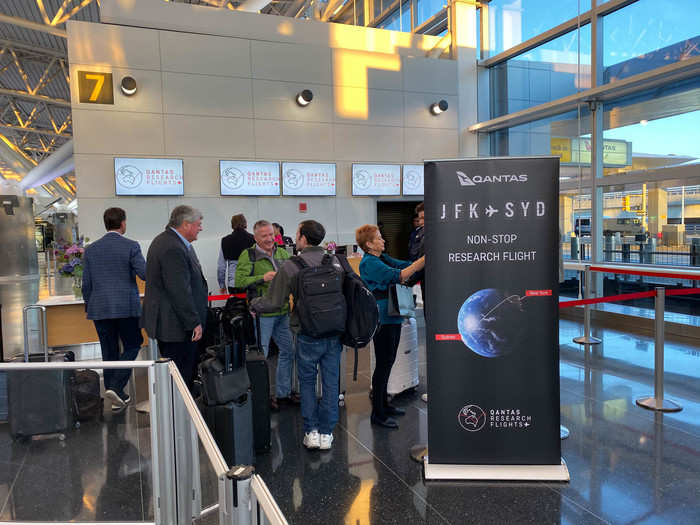
There was also a special touch on the boarding pass.
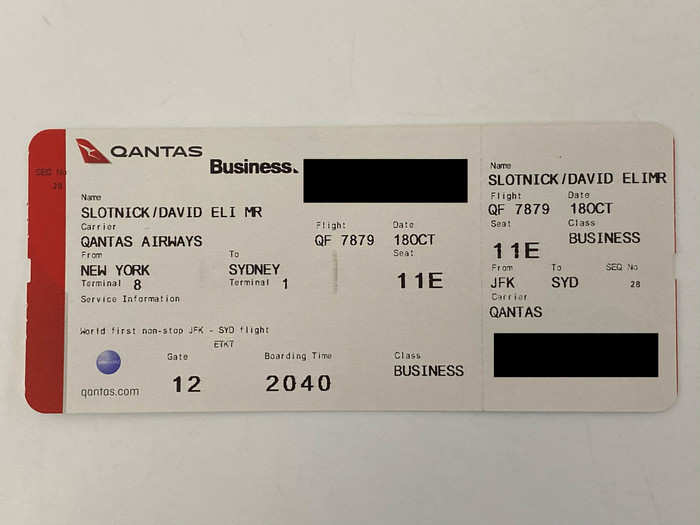
We headed through security to a cordoned-off area in the American Airlines lounge, as we waited for our boarding time.
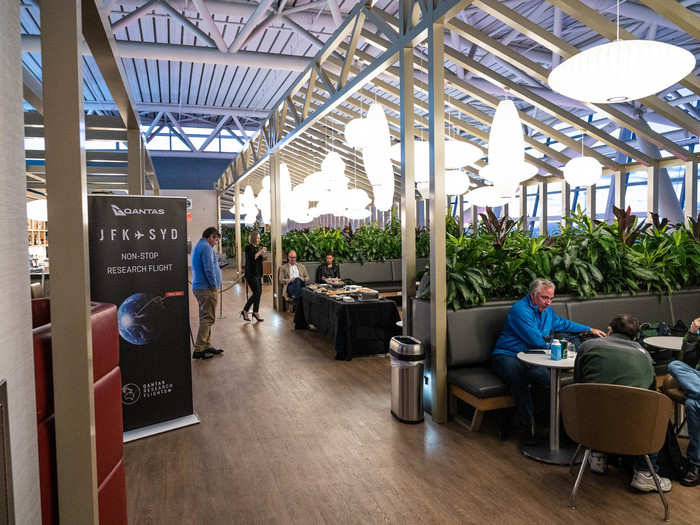
Soon enough, we went down to gate 12 and got a first glimpse of our home for the next day: a brand-new Boeing 787-9 airplane, registration VH-ZNI, delivered to Qantas from Boeing's factory in Seattle just a few days before.
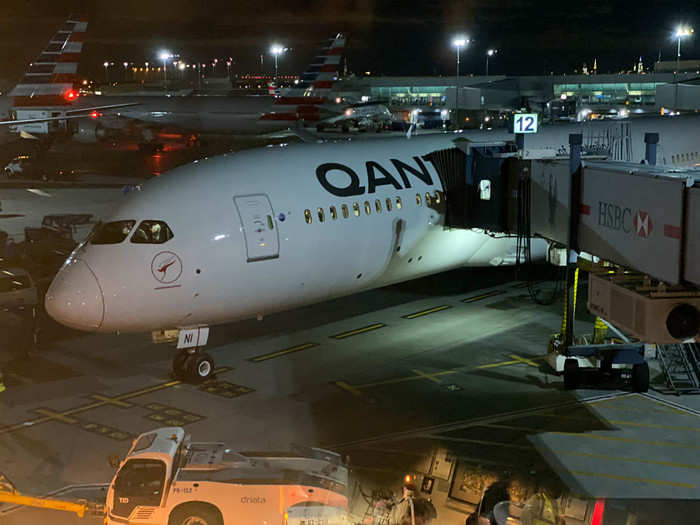
Here we go!
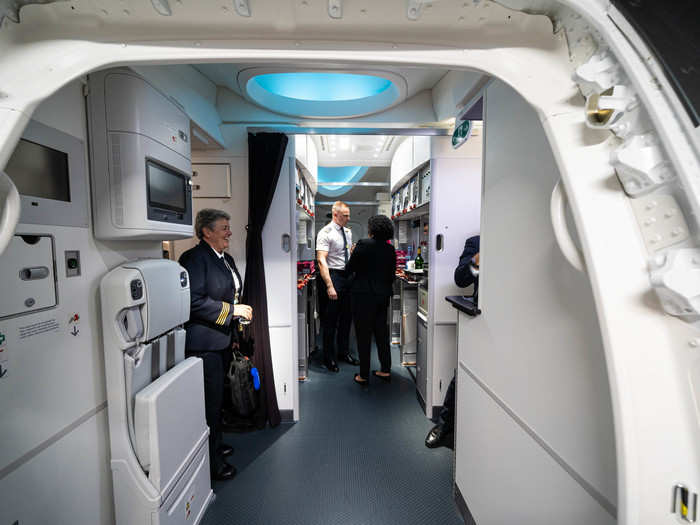
The business-class cabin on Qantas' 787-9s is split into two sections — a larger cabin to the left of the boarding door, and a smaller "mini cabin" with just three rows to the right. I was in the smaller cabin.
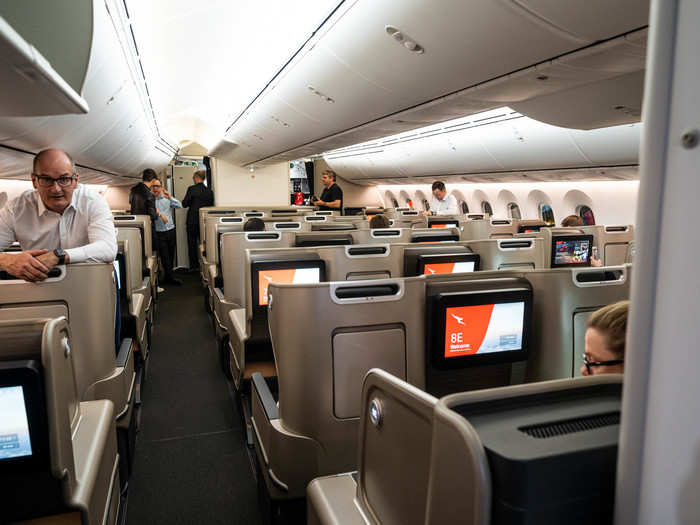
Here's my seat, 11E.
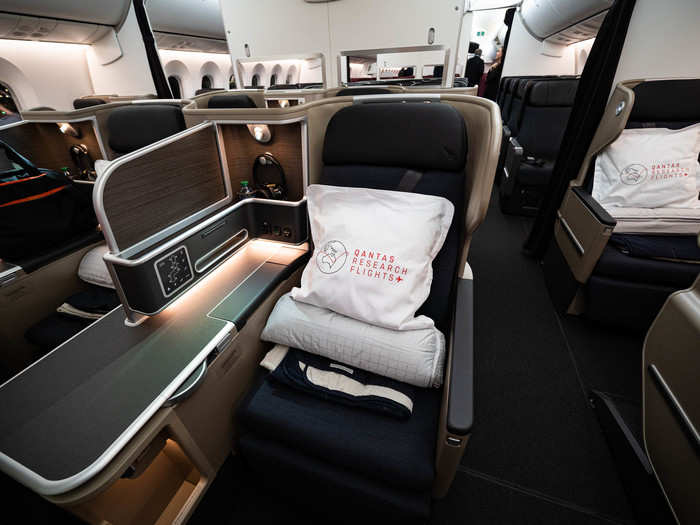
Each of Qantas' business-class seats has a small side table, and are consequently staggered, meaning some seats have the table between the seat and the aisle, and some seats — like mine — are directly against the aisle, and have the table on the inside. On some planes, this can feel a lot less private and make sleeping a bit harder, although it certainly wasn't an issue on this flight — more on that later.

Each seat had a pair of headphones ...
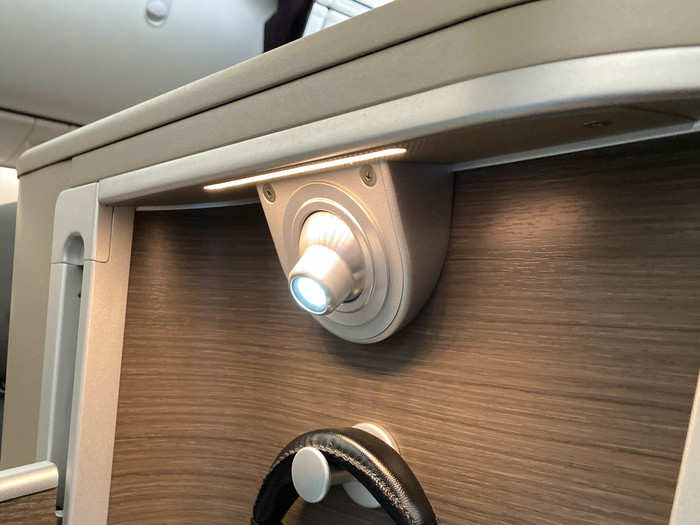
... which used a proprietary 3-prong plug that worked with the airline's in-flight entertainment system. Each seat also had a USB port and a universal power outlet...
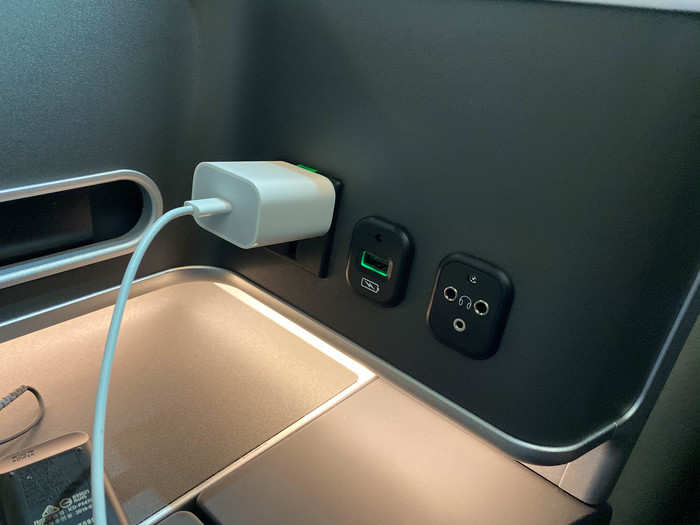
... and a small storage area down near the floor.
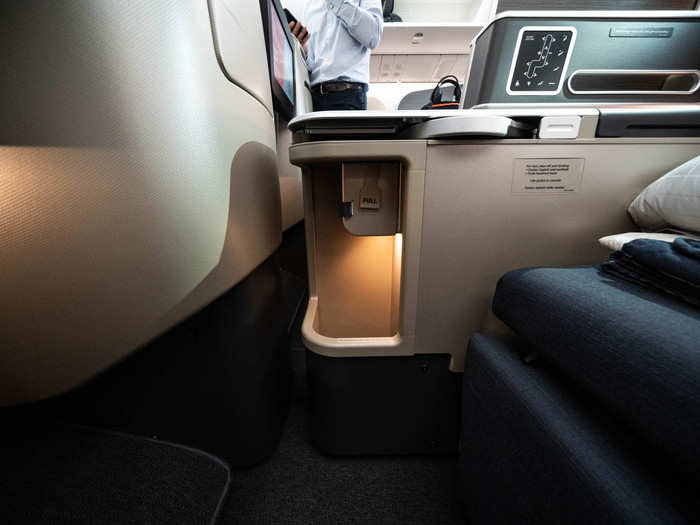
There was also a storage area in a cubby under the seat in front of me. When the seat is turned into bed mode, this serves as the end of the bed — there's plenty of room for your feet.
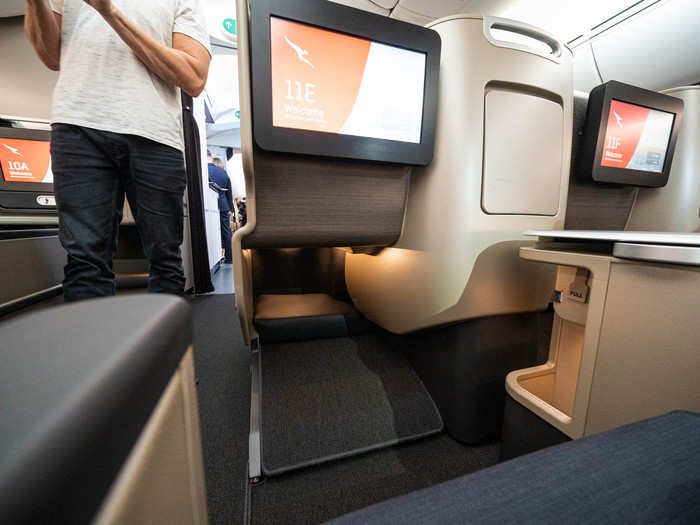
As we took our seats, flight attendants came around handing out Qantas' iconic business class pajamas...
... and this set was printed specifically for the Project Sunrise flights.
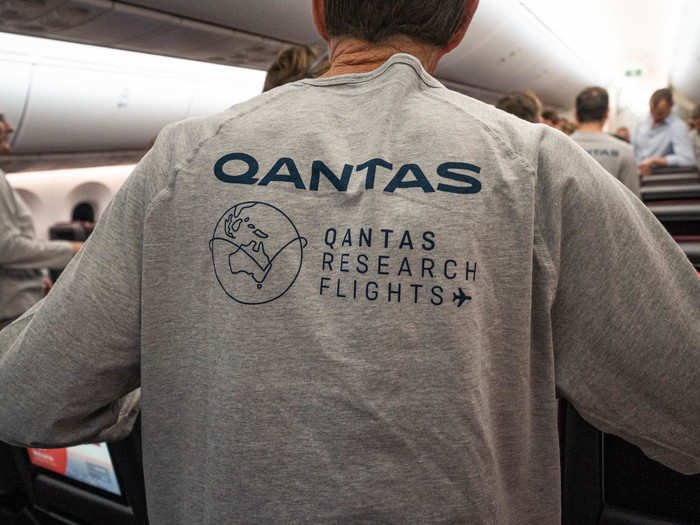
They also distributed amenity kits ...
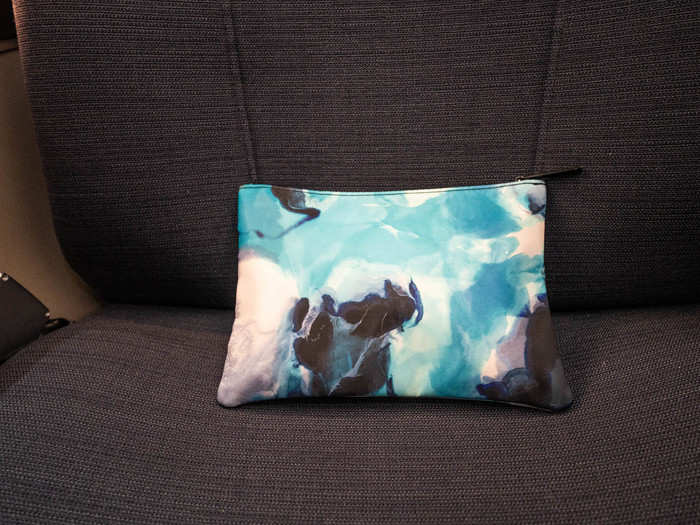
... stocked with in-flight essentials.
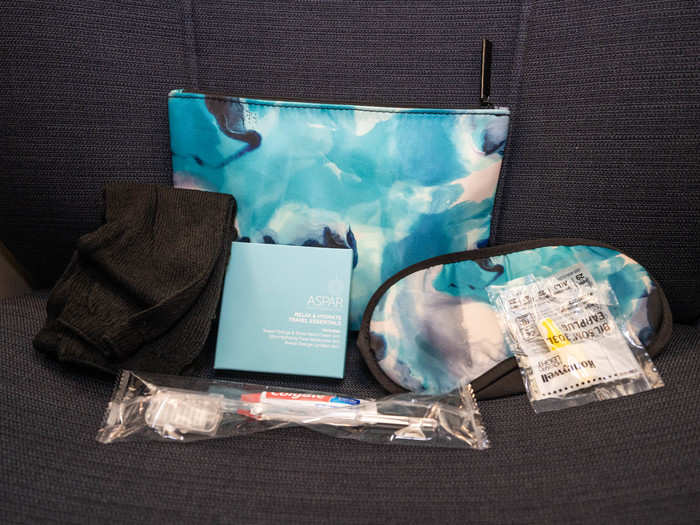
As we settled in, the cabin manager gave his unique preflight announcement.
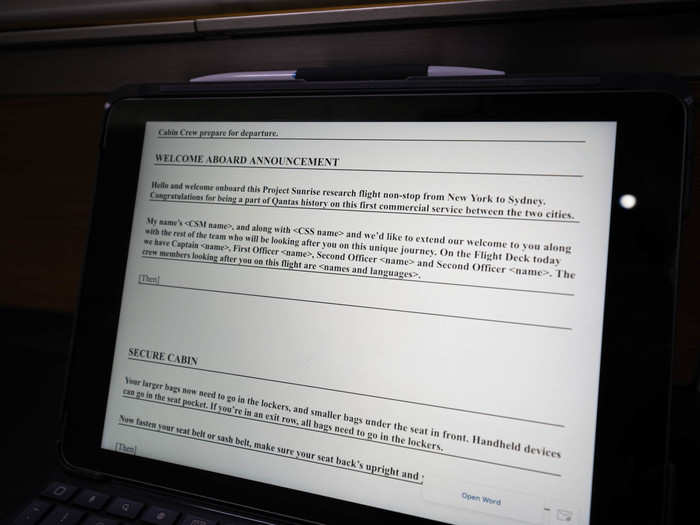
This may not have been a normal commercial flight, but many of the same rules applied — including the mandatory safety demonstration.
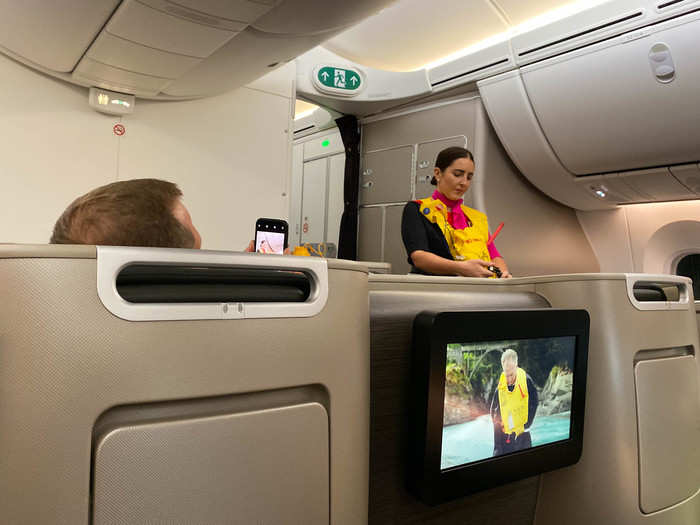
But aside from those formalities, this was very much not a normal flight. For instance, we got to see and access some things that most passengers don't even know exist, like the pilot's crew rest.
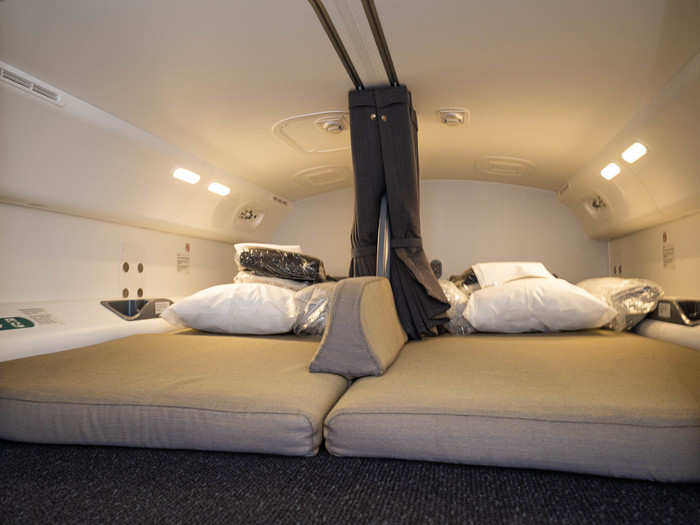
Because the main purpose of this flight was to study how pilots and cabin crew could remain properly rested and alert during ultra-long-haul flights, the four pilots worked out a customized work schedule, in conjunction with the researchers.
The pilot-in-charge, Captain Sean Golding, described the shift period for the four pilots, who worked in two shifts:
"The whole crew will be on for the first hour-and-a-half. Then, I'll take a two-and-a-half hour break. I'll work for the next five-and-a-half hours, sleep for the next five-and-a-half, work the next two-and-a-half, and we'll all be on for the final approach and landing."
"Sometimes, I sleep better on the long-haul flights than I do at home," he added.
To objectively measure the pilots' alertness and adaptability to the long flight, each of them was outfitted with an EEG (electroencephalogram) headset to measure brain activity ...
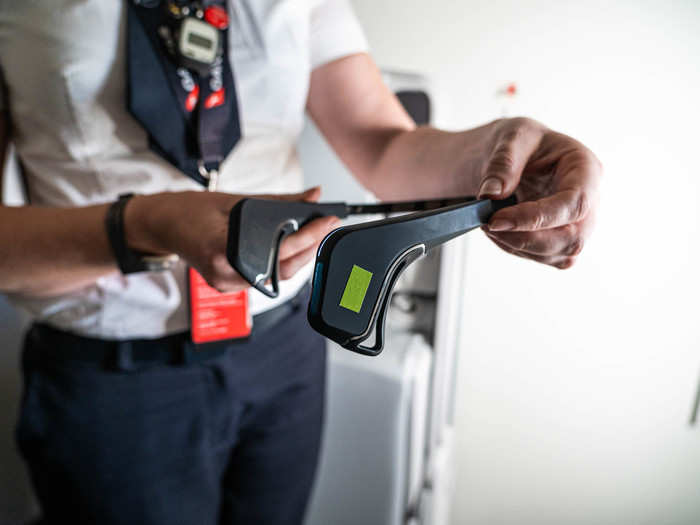
... an activity monitor ...
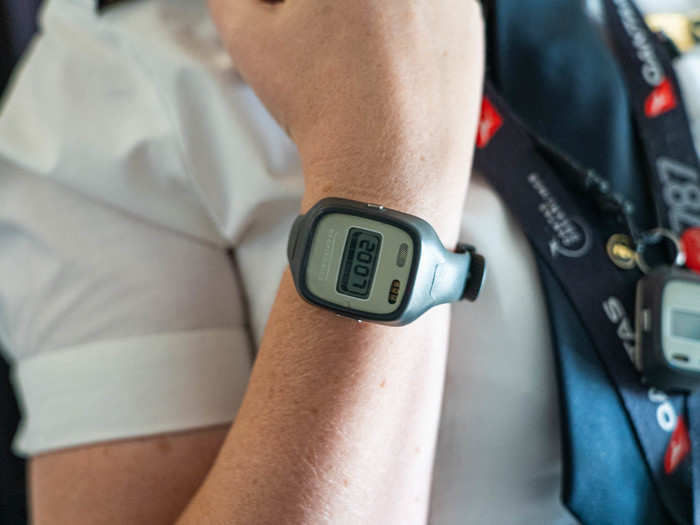
... and a light monitor.
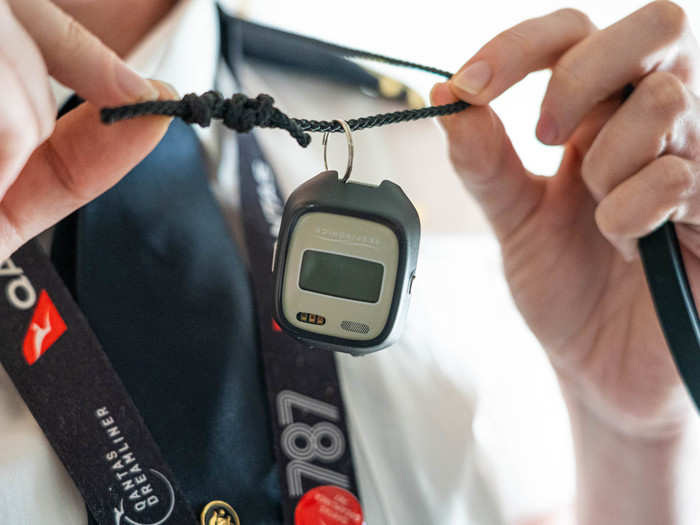
The pilots also gave urine samples every four hours, including before and after the flights, so their melatonin levels could be assessed.
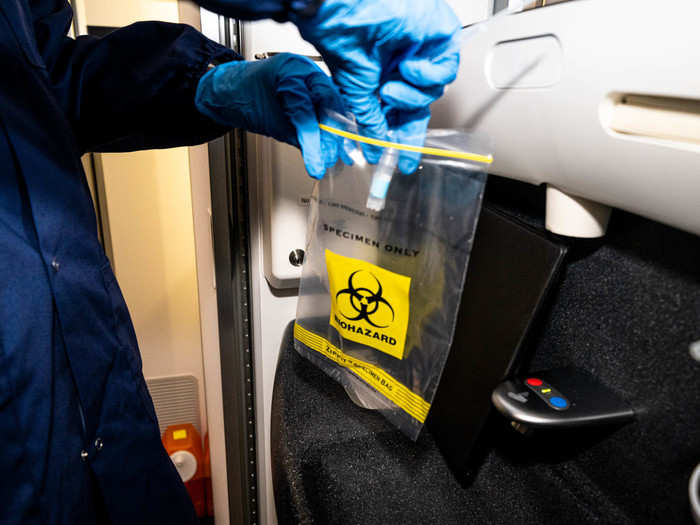
Passengers taking part in the research study wore slightly different activity monitors, and kept a journal logging their exercise, sleep, and meals in the days leading up to the flight — they'll continue these in the days immediately after.
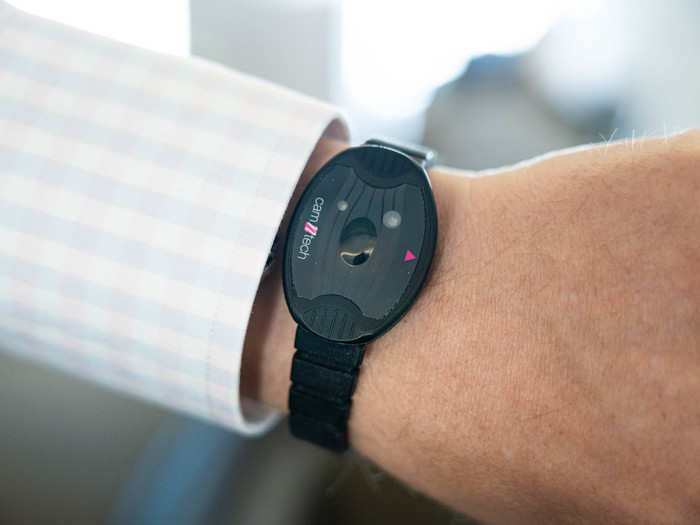
Passengers and crew also completed an iPad-based reaction-time test at regular intervals.
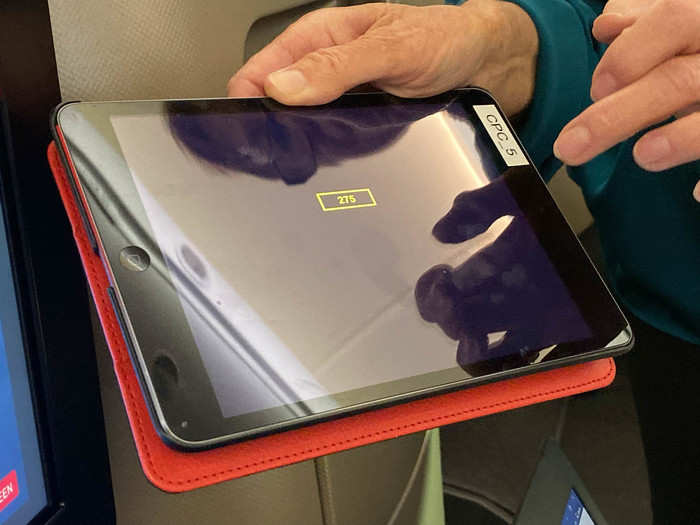
We also took a look at the flight attendant break area. Unlike the pilots crew rest, which only had two bunks, the flight attendant area had six — one for each member of the cabin crew.
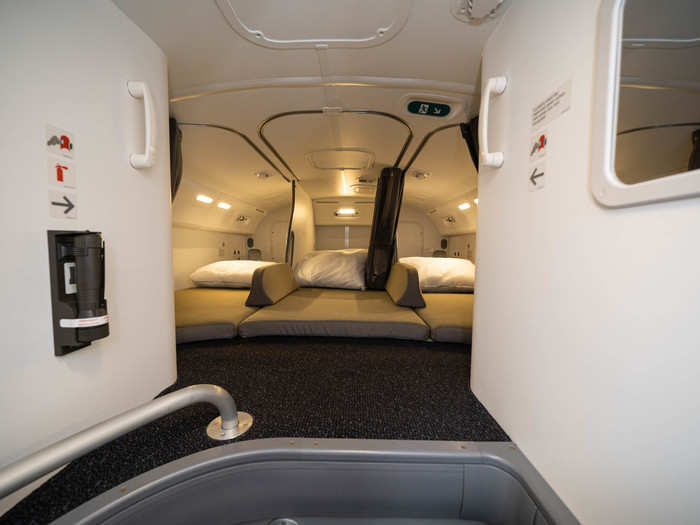
After a surprisingly short taxi to the runway, we were in the air at exactly 9:27 p.m. ET
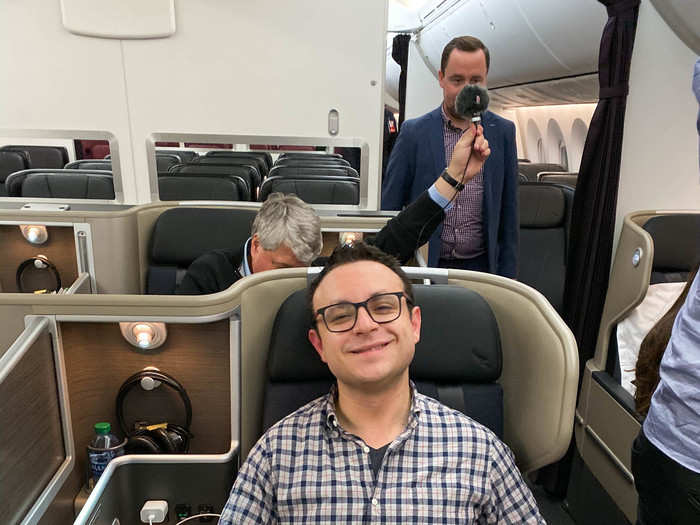
Another unique feature of this flight — aside from the fact that it only had 40 passengers on a plane that could fit more than 200 — was that the moment we took off, we began operating on our destination's time zone, rather than our origin's.
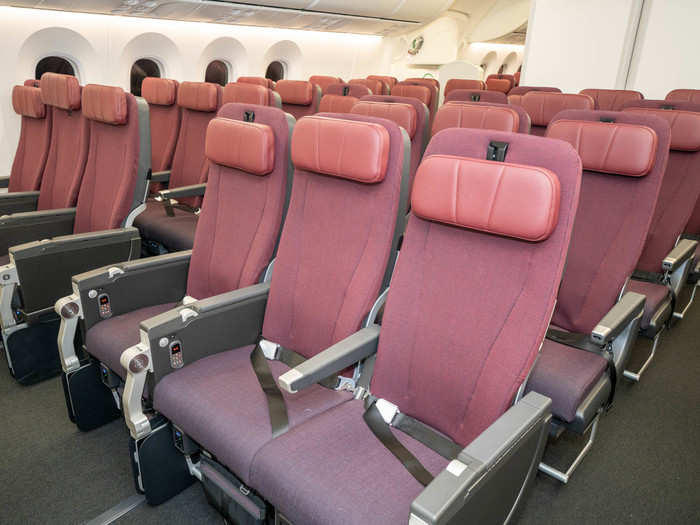
This was part of the anti-jet lag study being performed on several passengers. It was 12:30 p.m. Sydney time, so we had to stay up for at least a few more hours. The lights came up, and I took advantage of the chance to explore the rest of the plane.
Just behind the business-class mini-cabin were a few rows of Qantas' premium economy. I spent some time in the seats, and was very impressed.
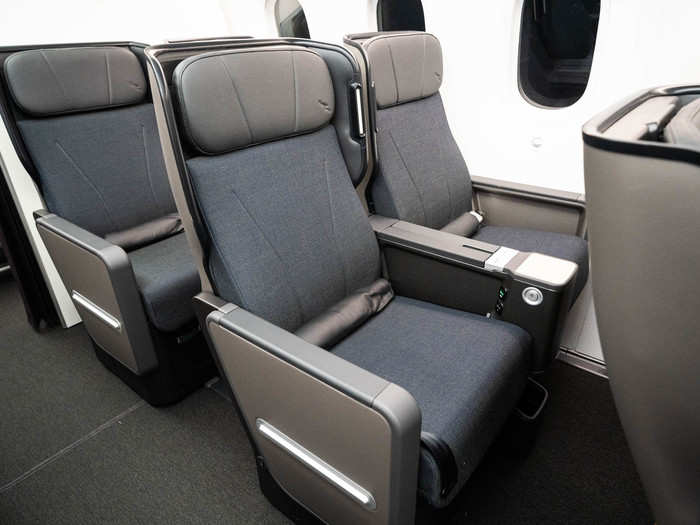
Some airlines' premium economy products are basically the same as coach, just with slightly larger seats and slightly better food. These seats, though, were much different from a standard economy seat. One Qantas employee described them as "more of a level below the full business class, rather than a small improvement on coach," and based on some time in the seat, I think that's a fair assessment.
A crucial aspect is the leg rest, which shockingly few premium economy products offer.
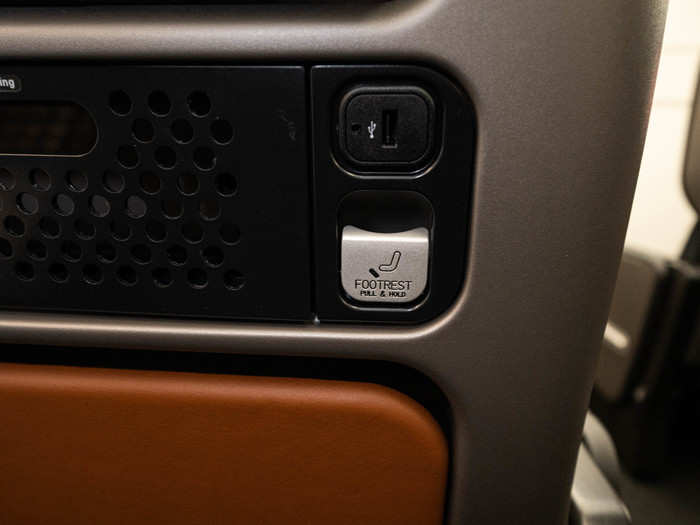
When it's extended and the seat is reclined, it's actually quite comfortable. There's a net beyond the leg rest which serves as a comfortable foot rest.
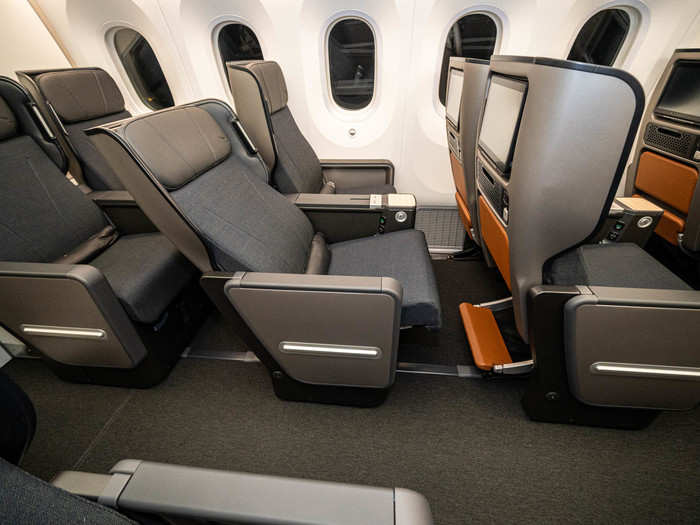
There's a decent amount of legroom, or pitch, as well. Even when the seat in front of you is reclined, it does so at an angle where there's still plenty of room for your knees.
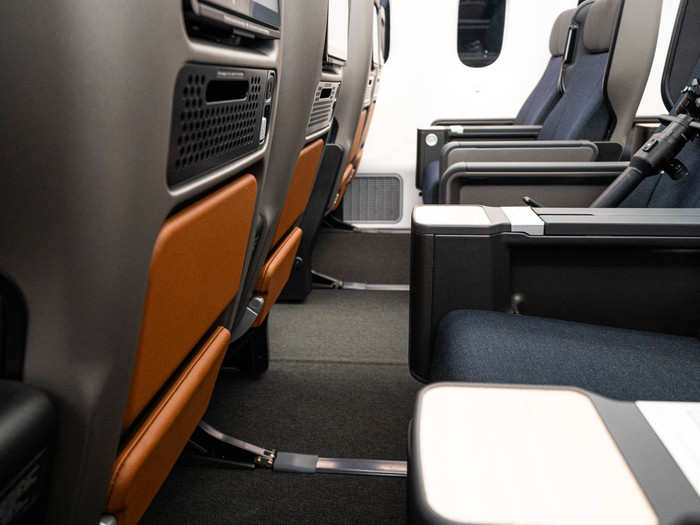
The economy cabin is closer to the standard product you'd expect, but it has a couple little tweaks that help make a long flight more bearable — although 20 hours in one of these seats would certainly be tough.
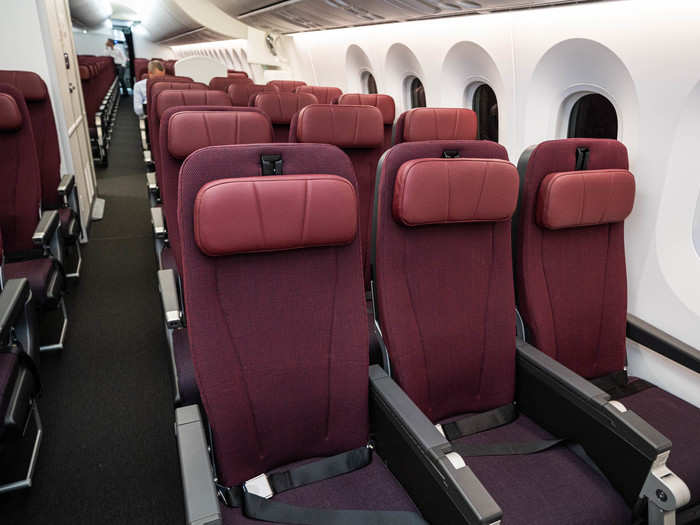
Qantas CEO Alan Joyce, who was on board the flight, said that although the eventual flight would have an economy cabin — compared to Singapore Airline's 18-hour Singapore-New York flight, which is operated by a plane with just premium economy and business class — the airline is looking at ways to make it bearable for an ultra-long-haul flight.
Some options, he said, include spacing the seats out to offer more leg room, as well as pulling some seats out to create a communal area for passengers to spend time during the flight. They could sit and chat in this space, stretch, or simply stand up for a few minutes to keep the blood moving.
Carl Petch, one of the passengers involved in the research study, said that an area like that would be crucial for making it through the ultra-long-haul flight in coach.
"You'd need a communal area to walk around, or do work, or something," he said. "You can't just sit for 20 straight hours."
Having fewer seats seems like it could be cost-prohibitive, but it may actually be a necessity. A low-density configuration will likely be required in order to boost the planes' fuel range so it can reach its destination without stopping to refuel.
Joyce also noted consistently positive ratings from passengers on the airline's nonstop flight between Perth and London, which, at over 17 hours, is only a little shorter than the Project Sunrise flights.
Economy seats have about 32 inches of pitch, which is on the higher side of standard for long-haul airplanes.
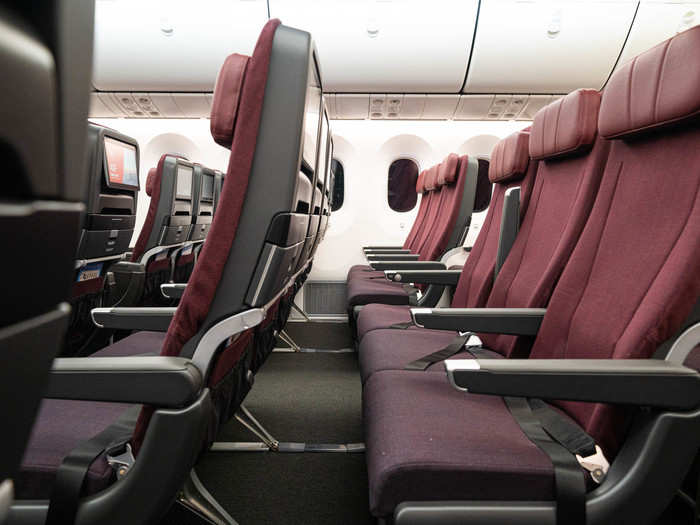
Economy seats also have an adapted version of the premium economy footrest, which was definitely an improvement.
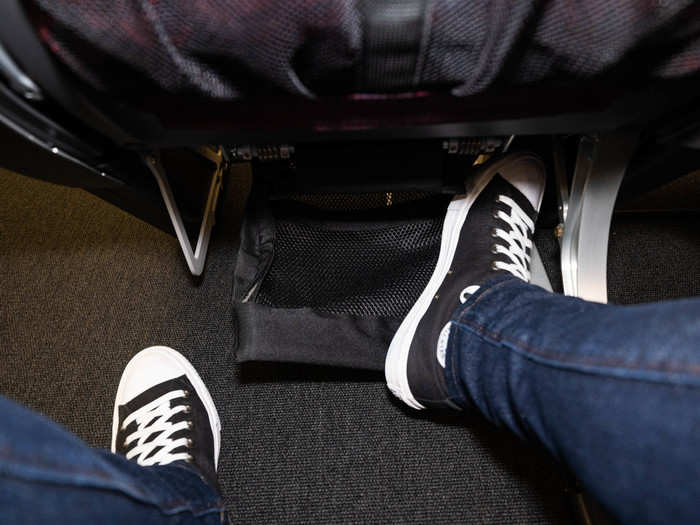
The flight menu offered a description of the full service schedule.
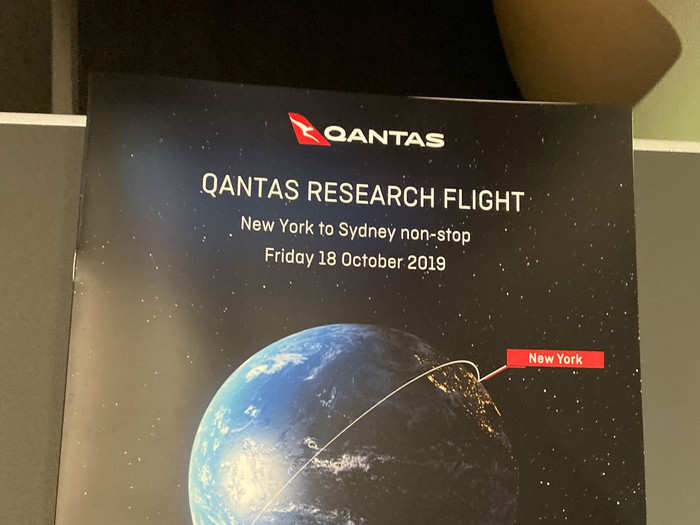
Here's the full "flight plan."
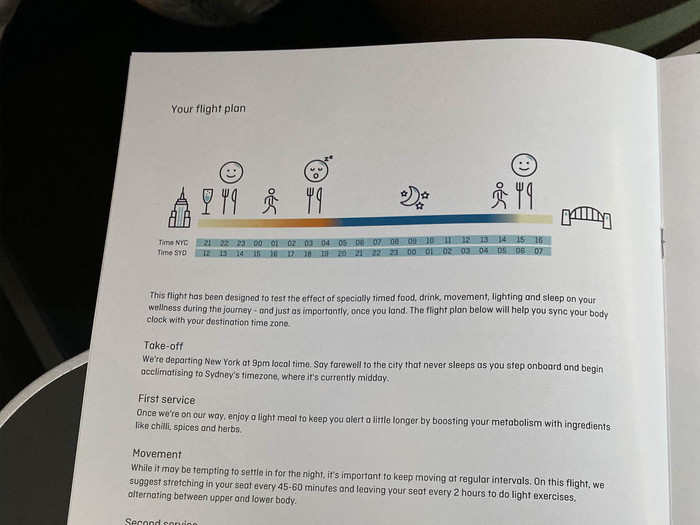
And here's the full menu ...
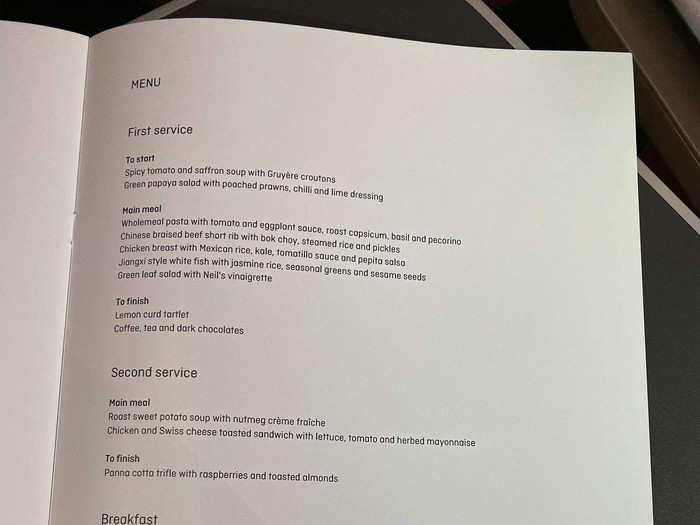
... along with a description of the rationale for the food options
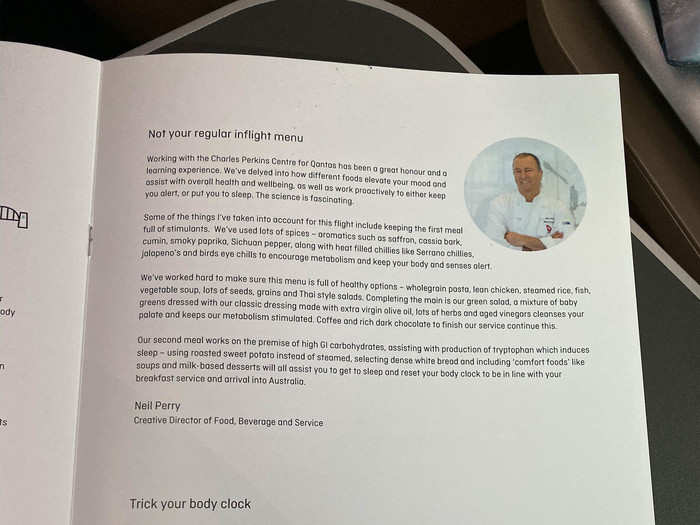
For the first course — essentially a late lunch, Sydney time — I started with the spicy tomato and saffron soup with Gruyère croutons. It was fabulous, not too spicy, but enough so that it was flavorful — and definitely helped me wake up. Reminder: the flight began operating on Sydney time (noon-ish) after we took off from JFK just before 9:30 p.m. ET, so this New Yorker was feeling ready for bed.
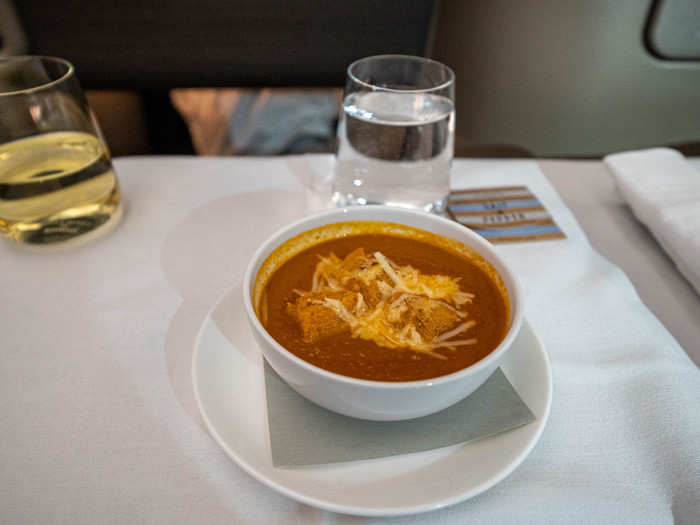
For the main course, I had the chicken breast with Spanish rice, kale, tomatillo sauce, and pepita salsa. This was genuinely phenomenal; I was blown away by how tasty it was.
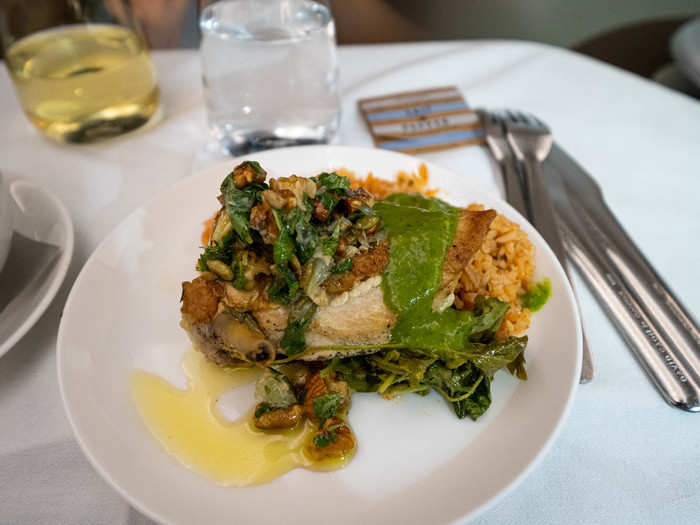
I was also genuinely impressed that the chef and cabin crew could put together something so tasty in such a small, cramped galley — even though much of it, obviously, was prepared before the flight.
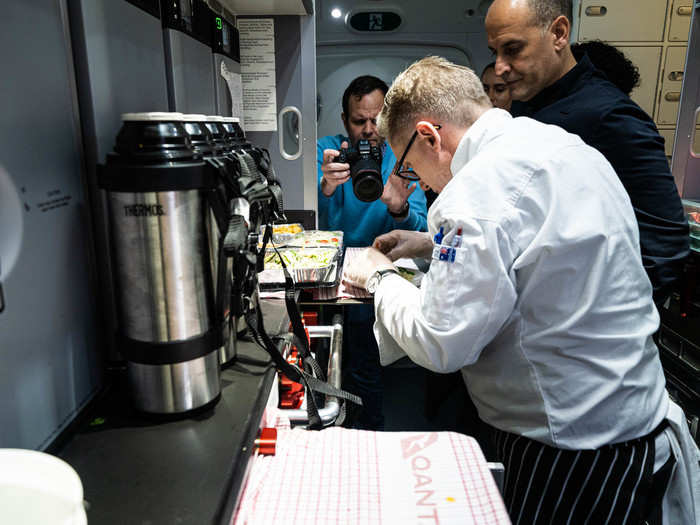
Here are the individual ovens used to prepare everyone's dishes ...
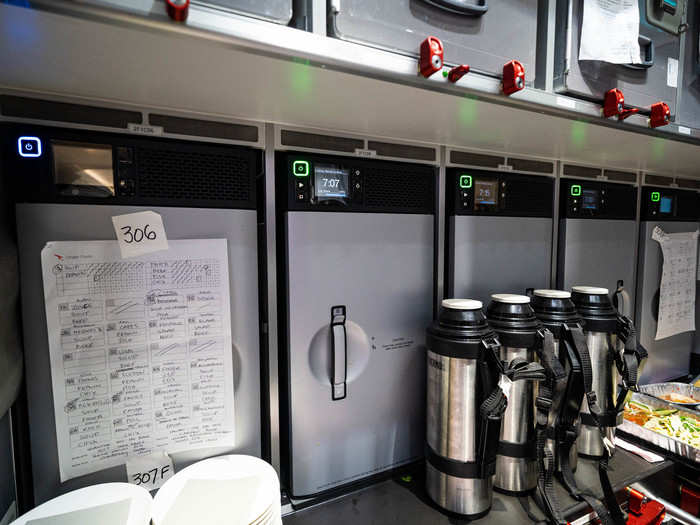
... and the order sheet the crew used to keep track of everyone's orders.
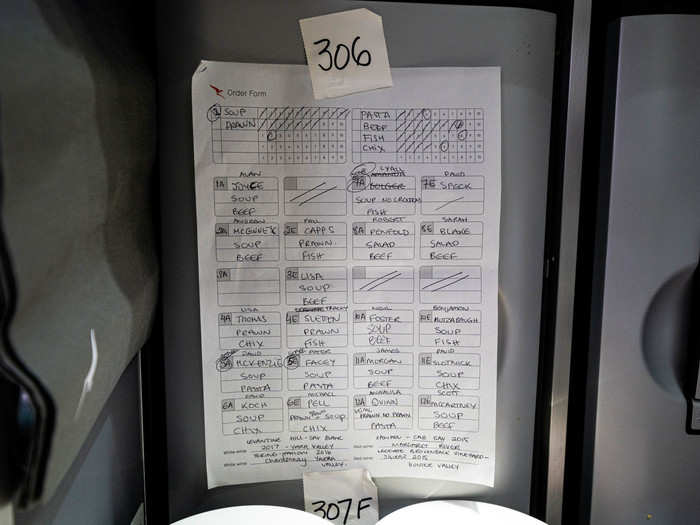
The tiny little galley was a flurry of activity, basically a fully functional kitchen in the sky.
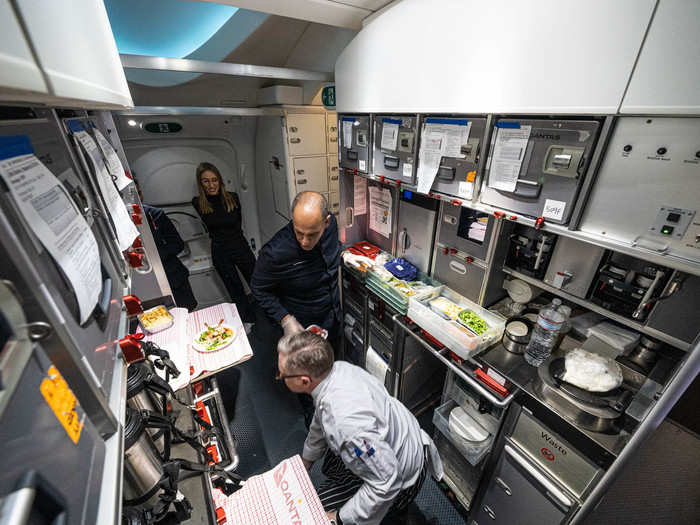
A little while after the first meal, Dr. Marie Carroll, the researcher leading the passenger jet-lag study, brought all of the participating passengers to the empty rear galley for a short group exercise, including stretches and squats.
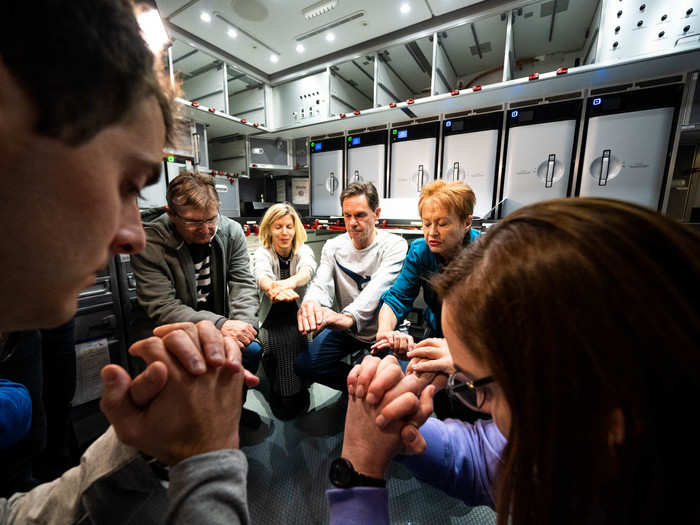
Dr. Carroll described moving during flight as a crucial part of mitigating jet-lag symptoms after ultra-long-haul flights. Eventually, other passengers and crew came over to participate, so the group moved into the aisles.
Even Alan Joyce, Qantas' CEO, joined in the exercises. It turned into something of a party, with Dr. Carroll playing "Macarena" over the PA system and leading a dance. Truly a unique experience.
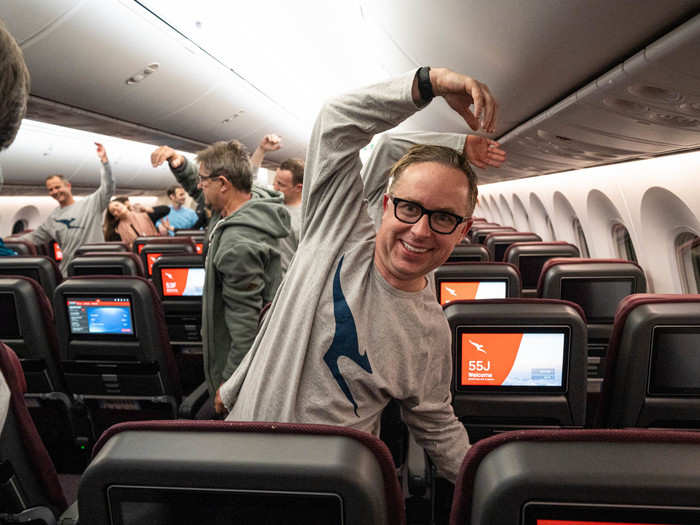
This would obviously be impossible on a normal flight, although Joyce said that the communal area he envisions on future ultra long haul flights could offer short guided stretch and exercise videos on monitors.
After the exercise party, I was getting quite tired. After all, it was two in the morning back in New York, and I had been up since a little before 7 a.m. However, following Dr. Carroll's advice — and not wanting to miss anything — I powered through, starting to process photos from earlier in the flight on my laptop.
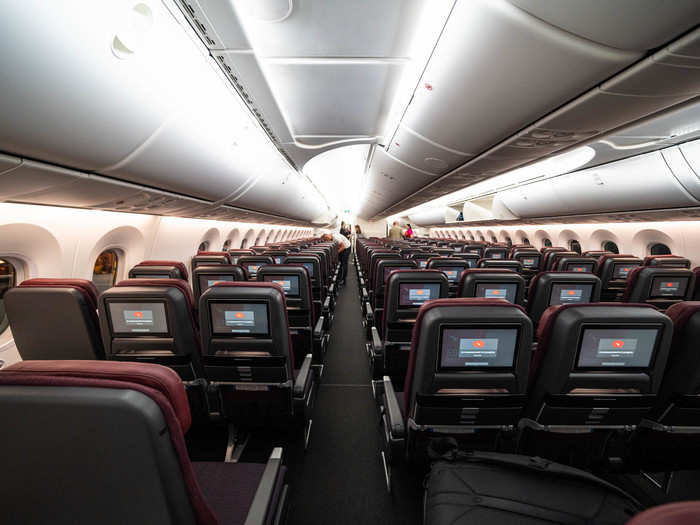
At around 3:30 a.m. New York time, or 6:30 p.m. Sydney time, the flight attendants took our orders for the second meal — "dinner" — and they came through to fit mattress pads onto our seats. "That way, you can go to sleep as soon as dinner's finished."
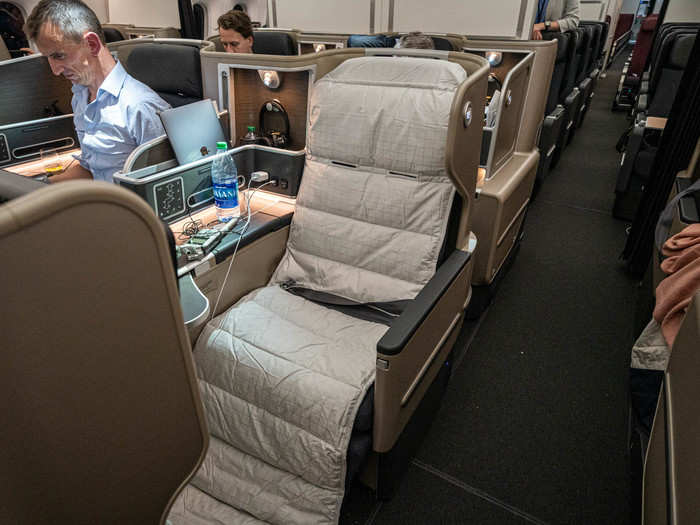
I started with a small bowl of the roasted sweet potato soup with nutmeg crème fraîche. Like the first meal, it was fantastic and flavorful, but definitely more of a sleep-inducing comfort food.
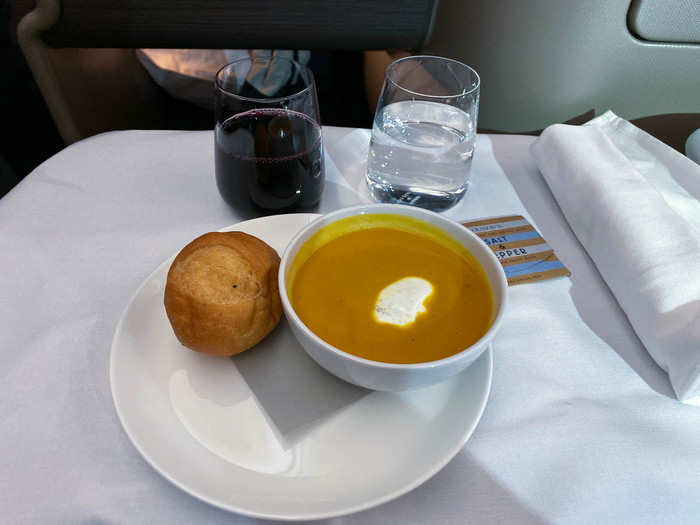
The chicken and Swiss cheese sandwich with lettuce, tomato, and herb mayo, also hit the spot.
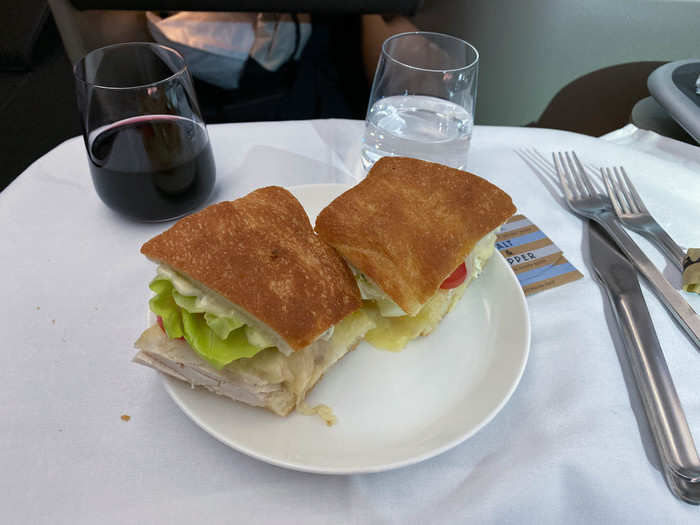
The dessert, though — panna cotta trifle with raspberries and toasted almonds — was the star. I devoured it.
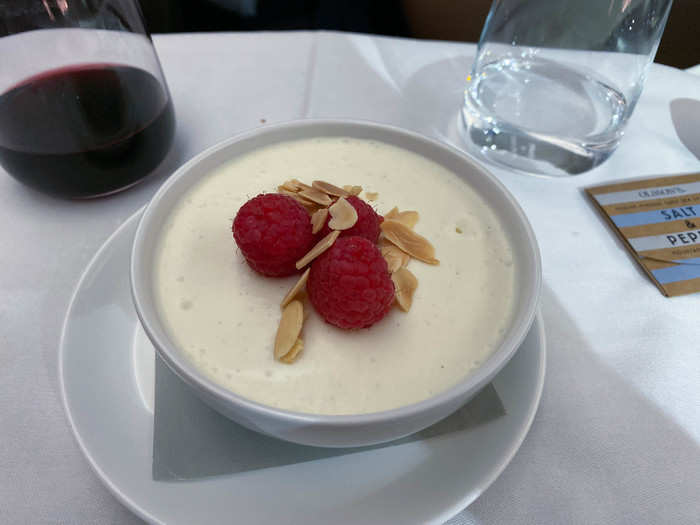
And then, finally, it was bedtime. A handy button on the seat control panel turned the chair into a bed in about 30 seconds.
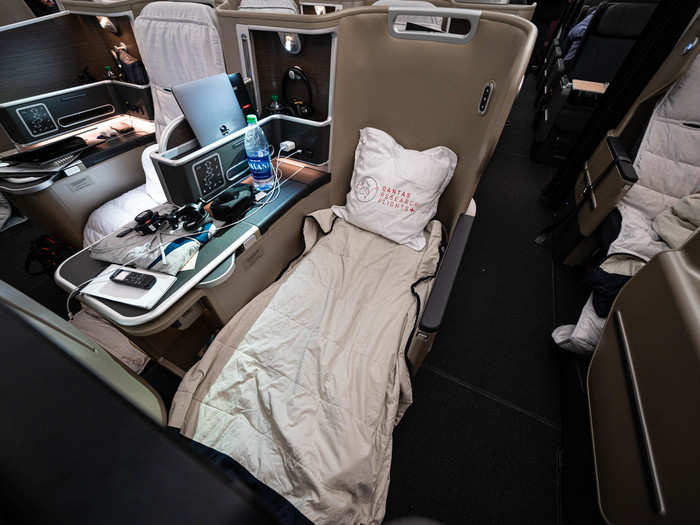
There was plenty of space in the footwell to be able to turn over comfortably, and the mattress pad made it quite comfortable.
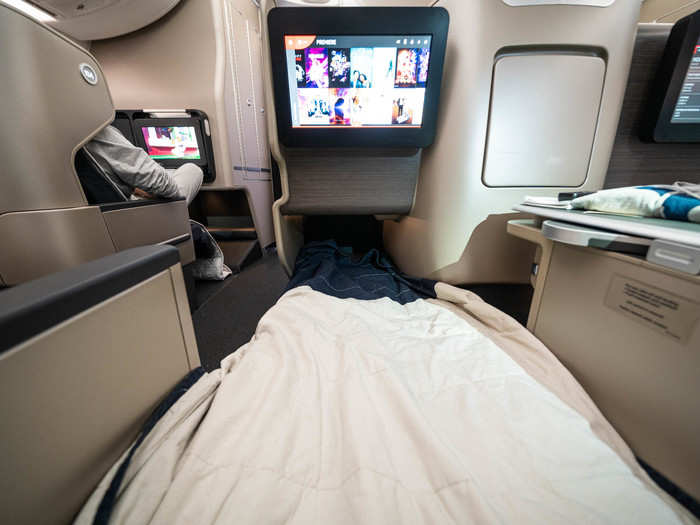
I slept for an astonishing eight hours and thirty minutes, my best-ever sleep on a plane, even in first or business class. I woke up once or twice because of turbulence or to use the lavatory, but I was still blown away by how well I slept, even considering how tired I was by that point.
For those lucky enough to be in first or business class, this strikes me as the ultimate advantage of an ultra-long-haul nonstop flight, compared to one with a stop — there's more time to settle in, and eventually sleep without interruption.
Nick Mole, one of the participants in the passenger research study, expressed similar sentiments toward the end of the flight.
Mr. Mole often flies in business class, but said that he generally feels better rested after an ultra-long-haul direct flight, rather than one with a connection, including Qantas' service to New York via Los Angeles.
"I feel better than I usually do," he told me. "The timing and service helped, and I got some good uninterrupted sleep."
Daniel Brescia, another passenger, agreed.
"I'm curious to see how the jet lag feels in a day or two, though," he added.
A few minutes after I woke up, warm-toned lighting gradually enveloped the cabin. It was almost time for sunrise for this Project Sunrise flight.
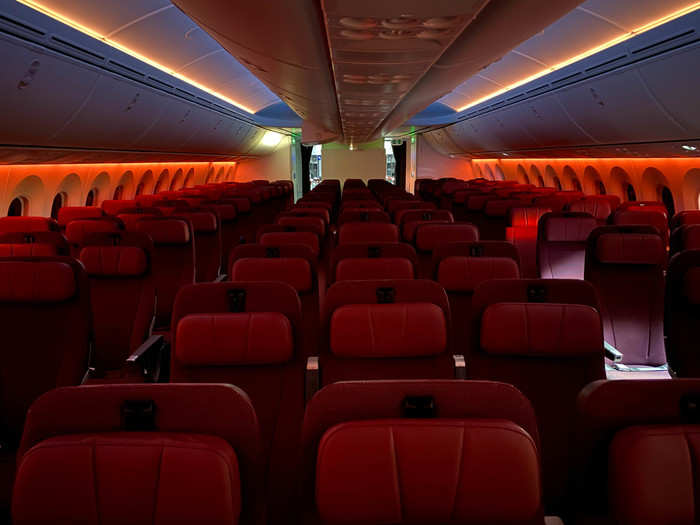
Gradually, I — and everyone else — stirred and woke, and the cabin crew kicked into action with breakfast. They kindly took our orders earlier in the flight, so that they could get breakfast ready right after we arose.
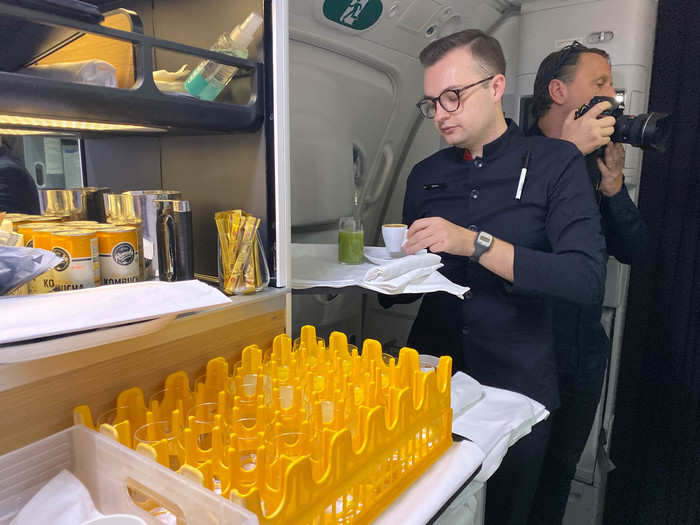
I started with the wild berry granola, a cold-pressed green juice, and, most importantly, a coffee.
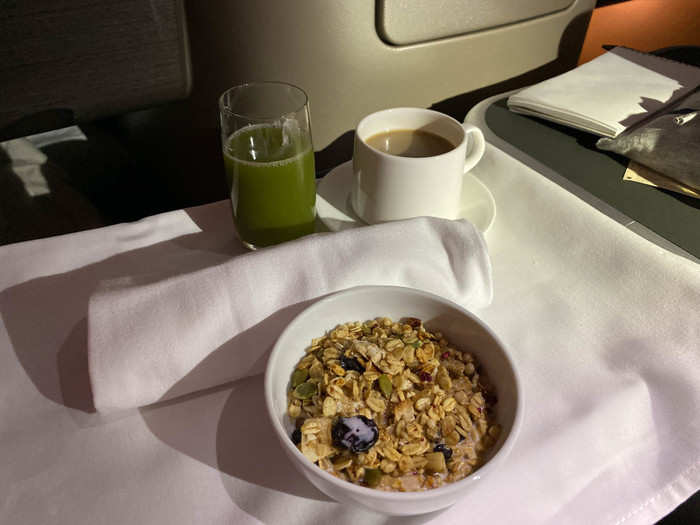
For my main, I had the egg, bacon, and herb tart (basically a quiche) with caramelized onion relish. Like everything else I ate during the flight, it was perfect.
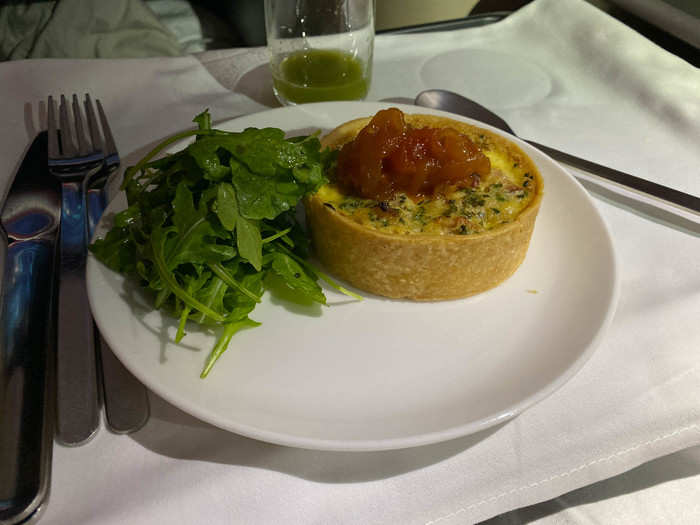
By the time we finished breakfast, the sun was fully up, and it was time to prepare for the end of our journey.
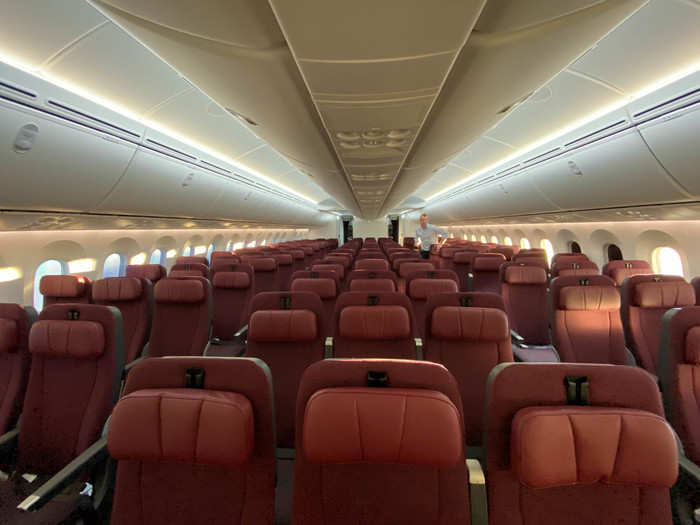
We entered Australian airspace at just around 5 a.m. Sydney time.
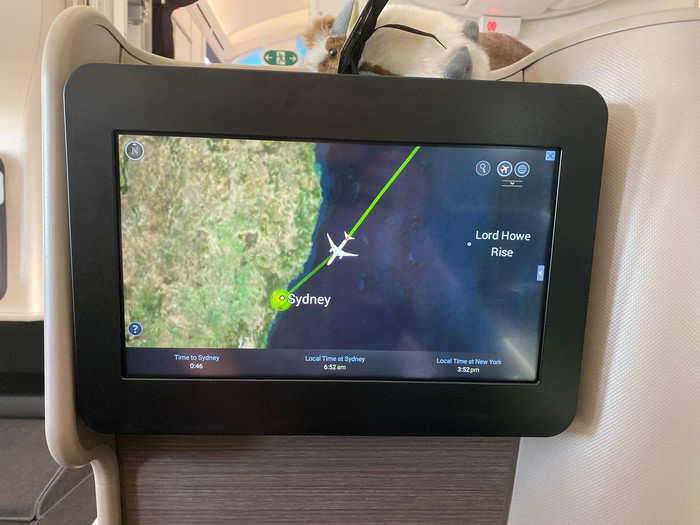
Captain Lisa Norman, the pilot who took delivery of the plane and flew it to New York for the Project Sunrise flight, said that Australian air-traffic control sent a text message to the flight crew as they entered the airspace: "Good morning. Hope everyone is still feeling fresh and comfortable."
The pilots replied: "Sunrise is dawning on Research Flight 1. Feeling good and fresh. Thanks."
It was pretty incredible to see the long journey coming to an end.
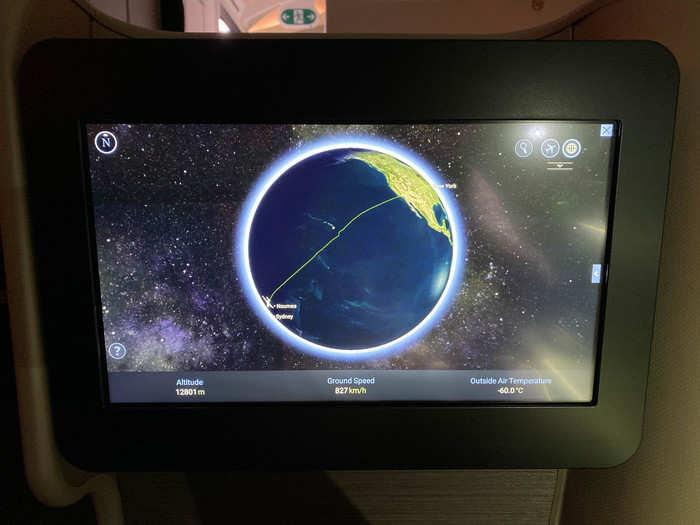
As we approached the Australian coast, the pilot-in-charge, Captain Sean Golding, came over the PA to point out a small speck to our right: QF12, the Qantas flight that goes from New York to Sydney, but stops in Los Angeles on the way.
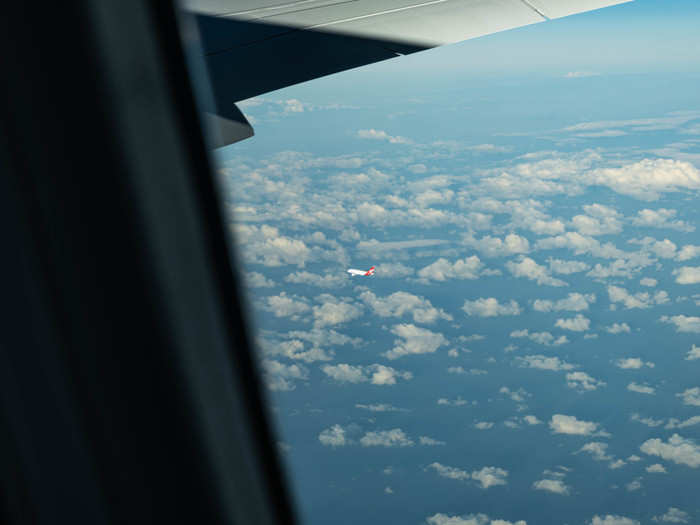
QF12 would land three minutes after us — despite leaving New York three hours earlier.
Captain Golding also said that based on the approach pattern we were given, there would be great views of Sydney Harbor on the left side of the plane. Thanks to the fact that the flight was mostly empty, those of us seated on the right and in the center were able to grab spare window seats on the left.
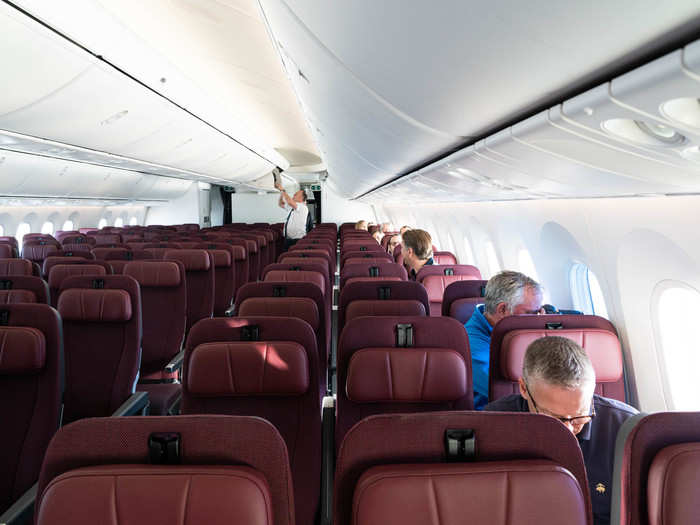
And wow, was he telling the truth. As we approached, we got incredible views of the Sydney Opera House and Harbour Bridge ...
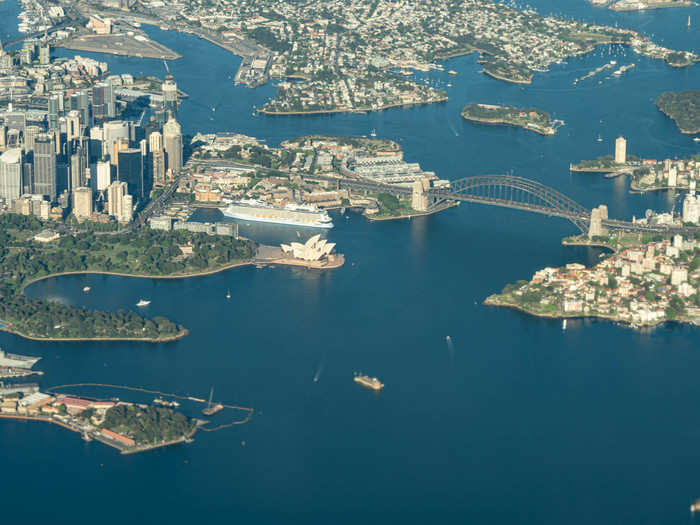
... and more views as we looped around to line up with the runway.
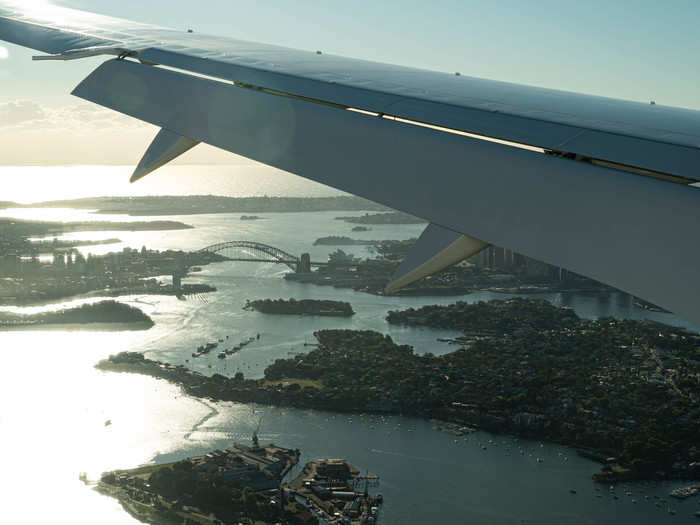
We landed at 7:43 a.m. Sydney time, 19 hours and 16 minutes after leaving the runway 31L at JFK.
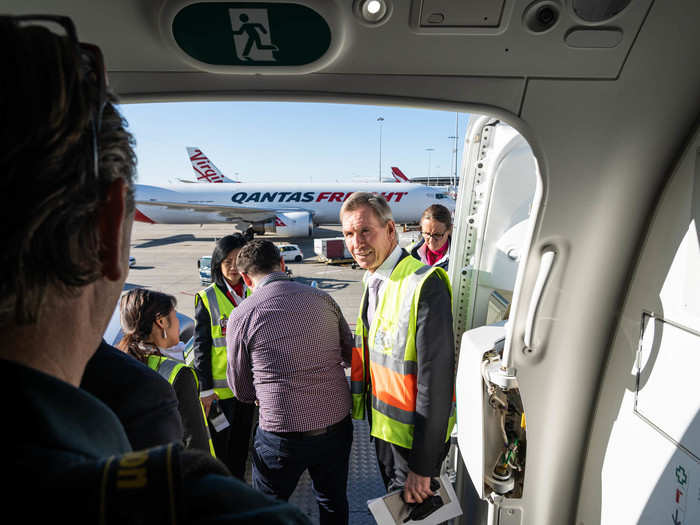
It was certainly the most festive disembarkation I've experienced. Here is the entire flight crew, plus the passenger research study participants.
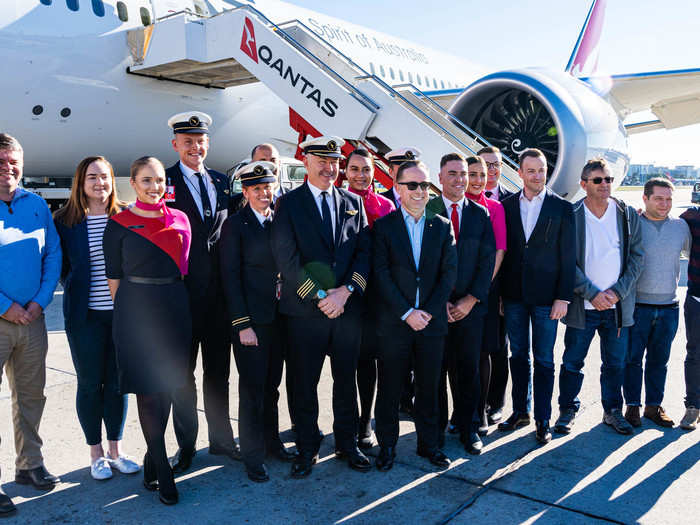
After more than 19 hours in the air, here's what I thought:
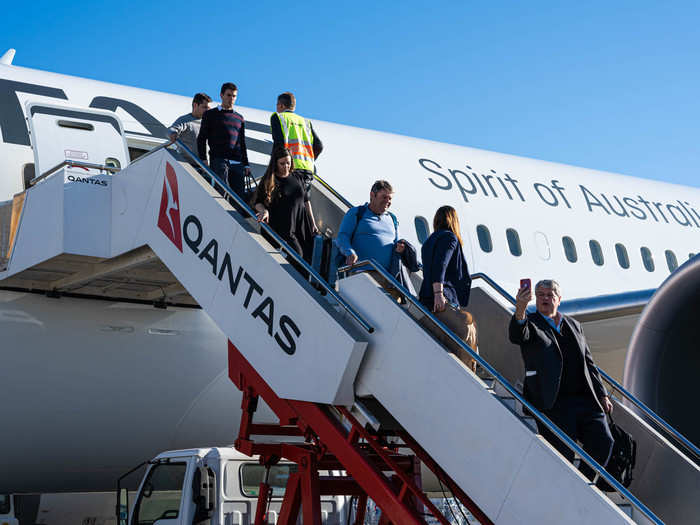
I felt better after this flight than I've ever felt after a long-haul flight, including those on which I was lucky enough to sit in a first or business-class cabin with a lie-flat seat. On 15-hour flights to Seoul and Tokyo, I've landed feeling utterly exhausted, while on shorter seven or eight-hour flights to Europe, by the time I manage to digest, relax, and fall asleep, it's practically already time to land.
For obvious reasons, I won't bother comparing the Project Sunrise experience to ultra-long-haul flights when I've been in coach. The longest I've ever done there was about 18 hours, although that included an hourlong refueling stop during which we could stretch our legs. Also, I was a kid back then.
I think that Qantas is onto something with this technique of immediately switching time zones, tailoring lighting, meal options, and service flow around sleep, and promoting healthy actions like stretching, staying awake until evening in the destination's time zone, and suggesting limiting alcohol before the second meal.
There's also something undeniably pleasant about being able to fly somewhere direct — especially when it saves as much as three hours, as we did compared to the QF12 flight.
However, I simply can't imagine a flight this long in economy with the current configuration and a full load of passengers. Joyce's discussion of adding pitch and a communal area makes me optimistic; this is something that Qantas will have to figure out if it wants to offer a full three or four-cabin configuration if and when the nonstop New York-to-Sydney route officially goes into service.
Popular Right Now
Advertisement